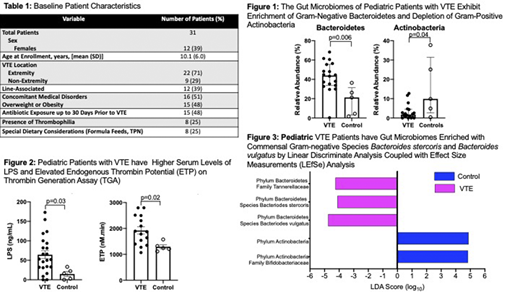Background: Pediatric venous thromboembolism (VTE) is a burgeoning clinical problem. As such, there is an urgent need to identify modifiable host factors to prevent VTE and its long-term adverse effects. The gut microbiome, which can influence host physiology and is implicated in the pathogenesis of several disease states, is one such potentially modifiable host factor. Gut microbiota dysbiosis is an imbalance in the composition of the gut microbiota that often manifests as an overabundance of gram-negative bacteria. Lipopolysaccharide (LPS), the glycolipid on the outer membrane of gram-negative bacteria and a heat stable endotoxin, can cross the gut epithelial barrier into the systemic circulation, where it leads to the activation of inflammatory and coagulation pathways. The association of gut microbiota dysbiosis and VTE has not been fully explored.
Objective/Hypothesis: The aims of this study were to determine if patients who develop VTE have 1) a distinct microbiota signature with an expansion of gram-negative bacteria, 2) increased systemic levels of LPS and 3) hypercoagulability as compared to controls without VTE.
Methods: In this case-control study, we obtained plasma and fecal samples on newly diagnosed VTE pediatric patients and age-matched controls. Gut microbiome profiling was performed on fecal gDNA (16S rRNA sequencing, V4 region; QIIME2 software for gut microbiota taxonomic composition determination). We measured LPS levels using a sandwich ELISA assay (Cusabio) and hypercoagulability using endogenous thrombin potential (ETP) on thrombin generation assay (Calibrated automated thrombogram) on plasma samples.
Results: 31 VTE patients were enrolled, of which 18 had fecal samples, and 22 had plasma samples. The median age of VTE cases was 11.0 years (range 1.0 to 19.0 years) of which 51% had underlying medical comorbidities and 48% had antibiotic exposure 30 days prior to the VTE episode. 5 controls were enrolled with a median age of 14.0 years (range 1.0 to 14.0 years). VTE cases had significant enrichment of commensal gram-negative bacteria Bacteroidetes (median 44% relative abundance compared to 21% in controls, p=0.006, Mann-Whitney) and depletion of commensal gram-positive Actinobacteria (median of 2% vs. 10% in controls, p=0.04, Mann-Whitney). Taxonomic differential abundance by linear analysis coupled with effective side measurements (LEfSe) further confirmed these findings by identifying two specific Bacteroidetes species as being enriched in patients with VTE: Bacteroides stercoris and Bacteroides vulgatus (p= 0.01 and 0.02 respectively, Kruskal-Wallis). VTE patients had significantly higher plasma levels of LPS (n=22; mean, 64.30 ng/mL; +SEM 10.17ng/mL) compared to controls (n=5; mean, 14.75ng/mL; +SEM 6.18ng/mL; p=0.03, t-test). Furthermore, VTE cases had increased ETP (n=15; mean, 1922nM.min; +SEM 144.5nM.min) compared to controls (n=5; mean, 1293nM.min; +SEM 78.11nM.min; p=0.02, t-test).
Conclusion: We present the first description of elevated LPS levels, hypercoagulability, and a concomitant gut microbiota enrichment of commensal gram-negative bacteria in pediatric patients experiencing an acute VTE episode. Our findings suggest that enrichment of commensal gram-negative bacteria in pediatric patients and LPS gut translocation could play a role in hypercoagulability and the development of VTE.
Koh:Mesoblast: Consultancy; Prolacta: Consultancy; Merck: Research Funding; Novartis: Research Funding.
Author notes
Asterisk with author names denotes non-ASH members.


This feature is available to Subscribers Only
Sign In or Create an Account Close Modal